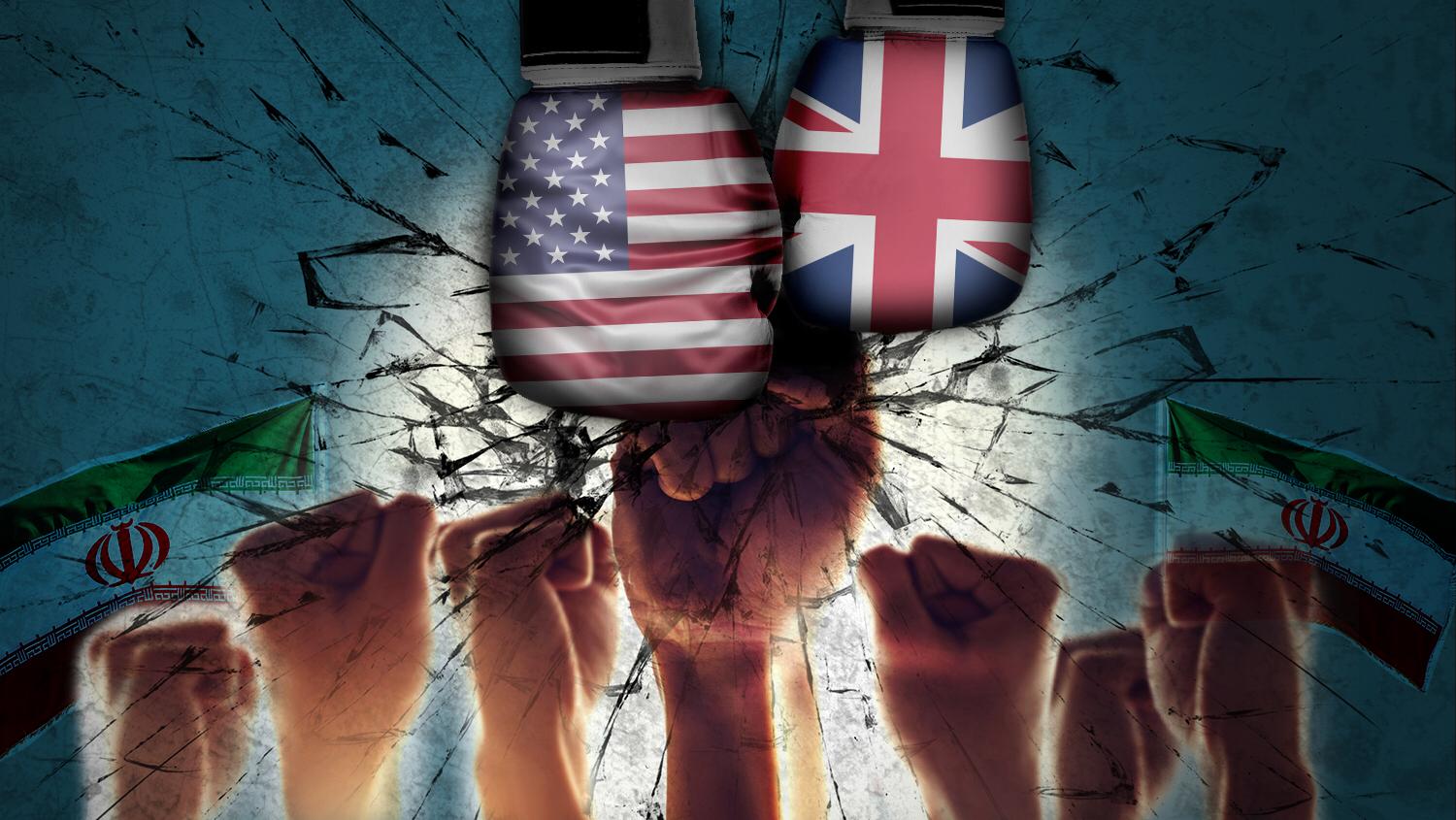In 1906, Iran was one of the first states in the Middle East to officially to become a democracy. However, in order to secure cheap oil from the country, the US and Britain overthrew progressive Prime Minister Mohammad Mossadegh in 1953 and turned Iran into a “pro-Western” dictatorship. In doing so, they also destroyed a great opportunity for Iran to become a model for a democratic, peaceful Middle East. Since then, the US and Iran have been at war with each other almost constantly.
In TV images, we have seen demonstrators in Iran burning US flags for decades. And the media portrays Iran as an enemy of the West and our democracy. Relations hit a low point when, in 1979, Iranian students occupied the US Embassy in Tehran and held diplomats hostage. In the wake of this crisis – US President Jimmy Carter failed to free the hostages, he lost the election to his successor, Ronald Reagan, who eventually succeeded in freeing them. In 1988, again, an Iranian passenger plane was shot down over the Persian Gulf by the U.S. warship USS Vincennes because it was mistaken for a military plane. 290 people onboard died.
Beginning in 2014, negotiations over the Iran nuclear agreement saw a short-term rapprochement between the two countries until US President Donald Trump brought relations back to a standstill. The latest low point in relations was the targeted killing of Iranian General Qasem Soleimani by a US drone in January 2020. And that is just a small excerpt from a long list of political and violent confrontations between Iran and the United States.
Overview of armed conflicts between US and Iran
1953: CIA organizes violent coup against Iranian Prime Minister Mossadegh. 1979-1981: Iranian students take Americans hostage at U.S. Embassy in Tehran. 1980: In the Iran-Iraq war, the U.S. supports Iraq. Quasem Soleimani is there as a Revolutionary Guard on the Iranian front. 1983: The pro-Iranian militia Hezbollah claims responsibility for an attack on U.S. naval headquarters in Beirut in which over 300 people lost their lives. 1988: U.S. shoots down Iranian passenger plane, killing 290. 2017: After Trump denied Iranian citizens entry to U.S., Iran tests ballistic missiles as military provocation. June 2019: U.S. accuses Iran of responsibility for attacks on oil tankers in Persian Gulf. December 2019: U.S. conducts airstrikes on targets in Iraq and Syria linked to pro-Iranian militias. January 2020: U.S. kills Quasem Soleimani. Iran responds with attacks on U.S. bases in Iraq, accidentally shooting down a Ukrainian passenger plane, killing 176 people.
But how could it have come to this? Above all, this conflict was and is about coveted oil. Let’s take a look at the history of Iran.
Iran: The first democracy in the Middle East
 Shah Mohammad Reza Pahlavi engaged in long power struggles with the parliament.
Shah Mohammad Reza Pahlavi engaged in long power struggles with the parliament.
Iran was ruled by the Shah and his royal family until 1906. Shah means ruler in Persian. Detail on the side: the name of the game chess is derived from it. But back to the Shah: he ruled Iran in an absolutist way.
But this changed in 1906: In the so-called Constitutional Revolution, Western-oriented merchants, artisans, aristocrats and some clergymen fought for a parliamentary system of government and a modern legal system. This replaced the absolute monarchy at the time.
From then on, there was an interplay of power between the shah and parliament. Several times, the royal family took control again. The young Shah Reza Pahlavi also ruled authoritatively again for some time: at that time, he obtained parliament only to preserve the appearance of democracy.
Democracy or Monarchy? British side with King Reza Pahlavi
Shah Mohammad Reza Pahlavi, however, only came to power with the help of the British. And this was to the displeasure of the Iranian population: Great Britain was considered by the Iranians to be a hated exertor of influence.
Even Shah Reza Pahlavi’s father forged alliances with other powers in order to ensure his influence in Iran. He had worked closely with Germany since the 1920s, for example, even during the Nazi era. But when Syria fell under the control of the Axis powers at that time, the British put down a military uprising in Iraq. This was close to Nazi Germany. Then, Britain and the Soviet Union invaded Iran, deposed the old Shah, and appointed the young Mohammad Reza Pahlavi as the new “King of Kings” at age 21.
The rise or Prime Minister Mohammad Mossadegh
 Shah Pahlavi’s opponent: Prime Minister Mohammad Mossadegh. He led the rallying party “National Front,” consisting of liberals and socialists.
Shah Pahlavi’s opponent: Prime Minister Mohammad Mossadegh. He led the rallying party “National Front,” consisting of liberals and socialists.
But the royal family and Shah Reza Pahlavi then had to share power over Iran with Parliament. Shah Pahlavi’s opponent was Prime Minister Mohammad Mossadegh. He was democratically elected by the people in 1951 and presided over the Iranian parliament. Democrats like Mossadegh viewed the shah’s function as purely ceremonial-unlike the shah himself.
Prime Minister Mossadegh was extremely popular with the Iranian people. He provided robust social programs: a support allowance for the unemployed and sick, peasants no longer had to perform forced labor for their landowners. Mossadegh also embarked on his heart’s project: to nationalize Iran’s oil, much of which was in the hands of British corporations.
Britain strips profits off Iranian oil
Oil was already gushing in Iran at the beginning of the 20th century. But the Iranians themselves hardly benefited from it. The oil was produced by the British oil giant BP, known at the time as the Anglo-Iranian Oil Company. The profit share of the Iranians themselves was far less than half, only about 20 percent.
Great Britain, then a major power, was involved not only economically but also politically: Newspapers were bought, the government bribed. Iran became an “informal colony” of Great Britain.
The reason for the immense greed for oil was that after the end of World War II, global oil consumption increased dramatically. The whole world needed more oil. The unstoppable rise of the automobile happened simultaneously with the ever-increasing demand from the ever-expanding factories.
In addition, the world was in the midst of a Cold War: The world seemed divided in two, the two superpowers, the USA and the Soviet Union, were arming themselves militarily. And both needed oil to fuel their tanks and fleets. Thus, the extraction of raw materials such as petroleum increasingly became a cause of war in various international theaters. In the search for new oil deposits, the focus falls primarily on the Middle East. The world’s largest reserves are located there. And Iran is one of the most oil-rich countries.
The war for Iranian oil begins
 The Masjed Soleyman oil field. Iran’s oil wealth is both a curse and a blessing.
The Masjed Soleyman oil field. Iran’s oil wealth is both a curse and a blessing.
Prime Minister Mossadegh, however, wanted to hand over control of Iran’s oil to the Iranian state. He proposed to the British Anglo-Iranian Oil Company that it share half of its oil resources with the Iranian state, but Britain refused. Iran then dissolved the contract with the British oil company and nationalized the oil industry.
The British responded with economic warfare and imposed a ban on exports from Iran. British warships subsequently barricaded the Persian Gulf. And so the aberrant situation arose in which the Iranians could not sell their own oil on the world market.
Economic war against Iran
Britain was now trying to gain US support. But the American government initially remained neutral. The British were allies, but the US did not want to weaken Iran. It was still the Cold War: Iran was not to be driven into the arms of the arch-enemy Soviet Union.
And so Iran slid into a severe economic crisis because of the British blockade. The Shah took advantage of this crisis situation and refused to appoint a war minister to the elected head of state, Mossadegh. Prime Minister Mossadegh resigned in protest because of this. However, because of the many social measures and his anti-British stance, the latter had a broad section of the population behind him despite the economic crisis. When the shah then appointed Ahmad Qavam, a British-friendly member of parliament, as prime minister, protests followed.
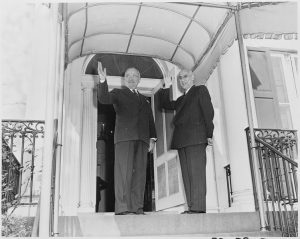 Iranian Prime Minister Mossadegh (right) with US President Harry S. Truman (left). Initially, relations with the US are good – later, the US suspects Prime Minister Mossadegh of being a communist and plans his overthrow.
Iranian Prime Minister Mossadegh (right) with US President Harry S. Truman (left). Initially, relations with the US are good – later, the US suspects Prime Minister Mossadegh of being a communist and plans his overthrow.
Broad sections of the population joined the protests. Even those who were originally opponents of Mossadegh. Religious, socialists, nationalists, and even communists demonstrated together in the streets, demanding Mossadegh’s return. Mossadegh eventually became prime minister again, but the support of the Communists hurt him in Washington. This was because during the Cold War, the communist Soviet Union was considered the US’s greatest adversary.
Fear of Communism: USA opposes Prime Minister Mossadegh
The US government in Washington, however, now fears that Mossadegh may be a communist. Originally, Mossadegh was quite popular in the U.S. Time magazine even named him “Man of the Year” in 1951. But the mood turned when Mossadegh showed himself willing to accept economic aid from the Soviet Union if necessary. At the same time, a new president came to power in the USA: the hardliner and anti-communist Dwight D. Eisenhower. The latter aligned his stance with the British: Prime Minister Mossadegh must go. The secret services CIA (USA) and the British MI5 jointly hatched a plan to overthrow Mossadegh.
Overthrow from the Outside: Operation AJAX
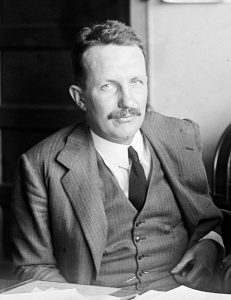 Kermit Roosevelt, son of former US President Theodore Roosevelt, leads Operation Ajax. He personally persuades the Shah to depose Mossadegh
Kermit Roosevelt, son of former US President Theodore Roosevelt, leads Operation Ajax. He personally persuades the Shah to depose Mossadegh
1953: The plan called Operation Ajax by the CIA and MI5 is in full swing. Britain wants power over Iranian oil back, the US wants to weaken communism. In addition, with the suppression of independence in Iran, they want to weaken other anti-colonial uprisings in what was then called the “Third World.”
The CIA’s director of operations is Kermit Roosevelt. He is the son of former President Theodore Roosevelt and, with a million US dollars in his pocket, is looking for supporters for the CIA plan. He finds what he is looking for in the Shah’s Iranian palace.
Roosevelt often allows himself to be smuggled into the royal palace for secret meetings with the Shah. The plan: The Shah should depose Mossadegh and install a general as a puppet.
The coup fails, however: military informants warn Mossadegh of the impending coup. The military continues to support Mossadegh and arrests the coup plotters.
Mossadegh speaks of an attack by the British on Iran – he mistakenly believes the US is still on his side. Mass protests by Mossadegh supporters follow, after which the Shah flees the country. Prime Minister Mossadegh triumphs for the last time.
Prime Minister Mossadegh is overthrown
But the CIA and MI5 do not give up. For: Mossadegh becomes increasingly vulnerable. Land reforms and the oil crisis have brought Mossadegh new enemies. He is trying to master the crisis with radical emergency decrees. Critics therefore accuse him of ruling in an authoritarian manner.
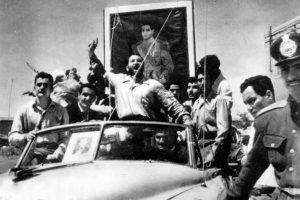 In order to overthrow Mossadegh, the CIA also recruits gangsters. Here, the street thug Shaban “the Brainless” Jafari (center, in front of the picture), is advertising for the shah.
In order to overthrow Mossadegh, the CIA also recruits gangsters. Here, the street thug Shaban “the Brainless” Jafari (center, in front of the picture), is advertising for the shah.
The CIA and MI5 intelligence agencies take advantage of this: They bribe politicians, officials and journalists. They pay demonstrators to provoke riots. They print and disseminate propaganda. Mossadegh lulls himself into a false sense of security.
With CIA money, anti-Mossadegh military and Islamic clerics launch a new coup: They pay demonstrators to pose as Communists or Shah supporters. These groups rioted in the Iranian capital Tehran on August 19, 1953.
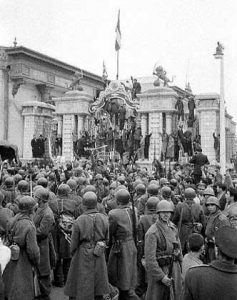 The army finally turns against Mossadegh. Soldiers occupy government buildings.
The army finally turns against Mossadegh. Soldiers occupy government buildings.
Citizens initially join the demonstrations, which turn into street battles between Communists and Shah supporters. The CIA also paid extra gangsters from Tehran’s slums to further exacerbate the violent nature of the protests. Under the pretext of trying to end the riots, the military finally intervenes. Government buildings are occupied. Mossadegh’s house comes under tank fire, and a short time later he is forced to surrender.
After his arrest, Mossadegh ends up in court and later in prison. In 1956 he is released and retreats to his private house – guarded by employees of the Iranian secret service SAVAK. He dies on March 5, 1967.
The End of Democracy
When Mossadegh is deposed, Shah Mohammad Reza Pahlavi returns to Iran with CIA support. The years of democracy are over: the Shah seizes absolute power. He has his political opponents hunted down and systematically tortured by the SAVAK secret service. In this way, the Shah eliminates Mossadegh’s supporters and the Communists – in line with the wishes of his supporters Great Britain and the USA. Iran becomes a so-called pro-Western dictatorship, closely allied with the US.
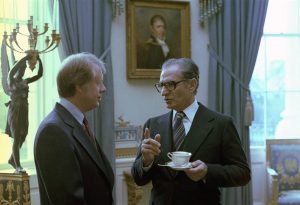 Shah Mohammad Reza Pahlavi (right) meets US President Jimmy Carter (left). Under the Shah, Iran becomes an important partner of the USA in the Middle East, although the country systematically oppresses its own population.
Shah Mohammad Reza Pahlavi (right) meets US President Jimmy Carter (left). Under the Shah, Iran becomes an important partner of the USA in the Middle East, although the country systematically oppresses its own population.
Dictatorship instead of democracy: Peace and prosperity for the Iranian people, who wanted to live in a democracy, fell victim to the economic-political interests of the USA and Great Britain. Some of the profits from Iranian oil now fell back to the British. However, from now on they also had to share with five US companies. And what happened next politically in Iran?
Iran becomes an Islamic Republic
For the Shah, however, his political career was over again in 1979: he had ruled the country for 26 years. A revolution swept him from the throne: under pressure from the US, he had somewhat relaxed the repression against his own people. And that ultimately proved to be his undoing. His opponents rallied across large segments of the population: Islamists, Communists and former supporters of Mossadegh and his National Front party eventually overthrew the Shah.
But once again, democracy did not follow the revolution: Islamists took advantage of the situation to eliminate their opponents and established an authoritarian “theocracy” in Iran.
Positions become increasingly polarised
During the revolution, the memory of former Prime Minister Mossadegh and the once-stolen democracy played a major role. To this day, the Iranian people blame the influence of Great Britain and the USA for their suffering. After all, the secret services of these two countries were instrumental in the fall of the then democratically elected Prime Minister Mossadegh.
This resentment on the part of Iranians was also evident when, in the course of the revolution, students stormed the American embassy in Tehran and took American diplomats hostage. Since this incident, up to this day, the fronts on the part of the United States have hardened. From now on, Iran is perceived as an enemy.
The US and its allies are hated in Iran to this day. The Islamism promoted by the Iranian government further strengthens the anti-American tendencies. Photo: Mohamad Sadegh Heydary, no changes have been made.
US flags burn regularly in Iran, whether after the assassination of Iranian officer Qasem Soleimani or during the dispute over Iran’s controversial nuclear program. To this day, the USA and Iran remain at odds.
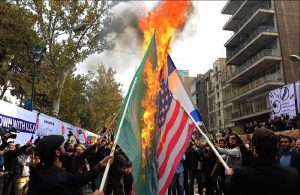 The US and its allies are still hated in Iran today. The Islamism promoted by the Iranian government further strengthens the anti-American tendencies.
The US and its allies are still hated in Iran today. The Islamism promoted by the Iranian government further strengthens the anti-American tendencies.
Late admission of guilt
The CIA itself did not acknowledge its influence at the time until 2016, on the 60th anniversary of the coup against Iran’s elected Prime Minister Mossadegh. For them, the coup against Mossadegh was pure power politics. The price: the loss of democracy for Iranians.
